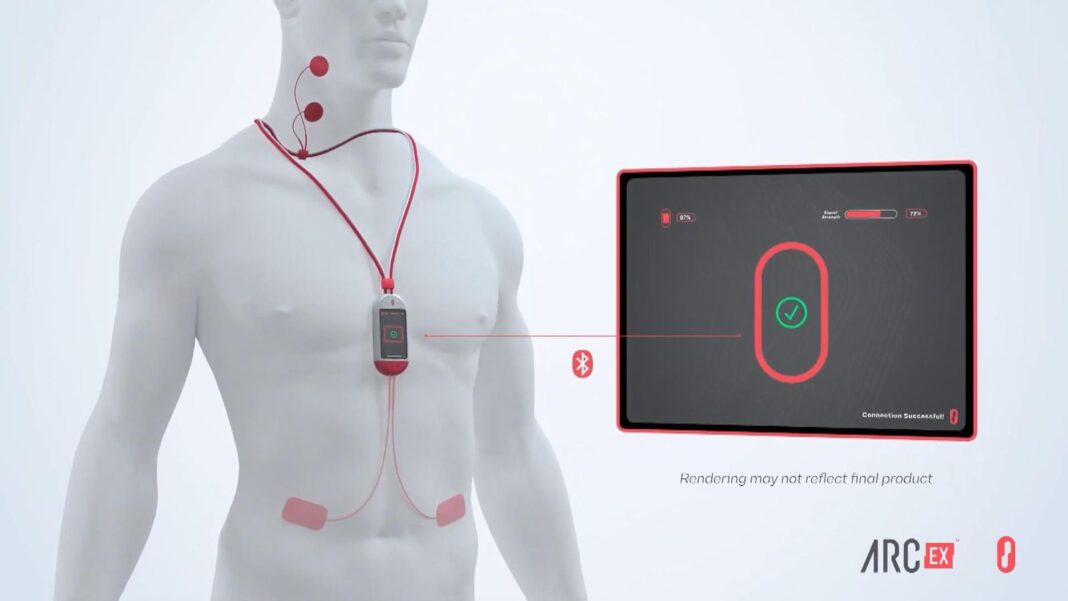A device that sends an electrical “buzz” through the skin could allow people who were paralysed several decades ago to regain movement in their arms and hands.
The ARC-EX device sends an electrical current to the spinal cord through surface electrodes, increasing strength, sensation and ability to move in people with paraplegia.
Volunteers who took part in the first clinical trial of its kind say the effects were astonishing.
Melanie Reid, a columnist for The Times newspaper, who was paralysed after falling off a horse 14 years ago, used the device for several months.
“Everyone thinks with spinal injury that all you want to do is be able to walk again, but if you are tetraplegic or quadriplegic [where all four limbs experience paralysis], what matters most is having working hands,” she said.
“My left hand has always been useless, with very little sensation.
“I’m delighted to say that after doing the trial, my left hand is much stronger.
“I can use it and got some grip back in it. I can scroll a tablet or phone, I can release the seat belt and put my hair in a ponytail, which I couldn’t do before.”

Melanie Reid says the device made her left hand much stronger
The international study included 60 patients who had their spinal injury between one year ago and 30 years earlier.
All had a clinic-based rehabilitation programme for two months, followed by the same rehab but this time with the addition of ARC-EX stimulation therapy.
According to results, published in the journal Nature Medicine, 90% had clinically meaningful improvement in one measure of strength or function, and 72% in two measures.
Significantly, 87% reported a better quality of life.

Some 87% of people in the trial reported a better quality of life. Pic: Medical N.V
Dr Chet Moritz, a rehabilitation medicine specialist at the University of Washington in the US, and one of the study co-authors, said: “The difference with this stimulation is that it doesn’t directly cause the movement as many prior treatments do.
“It actually makes it easier for people to move, including people who have complete loss of movements in their hands and arms.
“There are benefits even when the stimulator is turned off.
“We believe it is healing part of the damage to the spinal cord injury such that the benefits persist beyond stimulation.”

The device involves electrode pads worn over the spinal cord. Pic: UW Medicine
‘A strange sensation’
The ARC-EX device, made by the company Onward Medical, is a small box that is programmed to deliver a specific pattern of electrical pulses at high frequency through electrode pads worn over the spinal cord.
Scientists involved in the trial believe the high frequency numbs pain nerves in the skin so a stronger electrical current can be sent to sensory nerve fibres within the spinal cord.
Read more:
Human with brain chip ‘can control computer mouse just by thinking’
Paralysed man walks again thanks to ‘digital bridge’
This not only makes the treatment more effective than previous attempts at stimulation, but also enhances the growth of new nerve connections, they said.
“It’s possible this device won’t function for those 10% of people who have complete anatomical separation between the brain and lower spinal cord,” Dr Moritz said.
“But for the other 90% of the people, I think it’s a good candidate.
“We have seen people with no movement in their hands and arms regaining movement while they experience this stimulation.”

Researchers showed people in the trial performing tasks, even playing the guitar. Pic: UW Medicine

Pic: UW Medicine
Ms Reid said she felt no pain from the stimulation, only a “buzz”.
“It’s a strange sensation, but not unpleasant,” she said.
“I can only wish this had been around 14 years ago. It would have meant so much and done an enormous amount of good at an early stage of my injury.
“After 14 years, you kind of think ‘I am where I am’, nothing’s going to change.
“And suddenly to find that I had more power and function in my fingers and thumb that were completely useless before was extraordinary.
“Psychologically it makes you put your head up, your shoulders back and look at life differently.”

Keep up with all the latest news from the UK and around the world by following Sky News
The researchers believe the electrical stimulator could in future be used to help people with paralysis to walk, as well as improve recovery from strokes.
Other companies are developing implantable devices that can improve movement and function in people with paralysis, but having a non-invasive option is significant.







